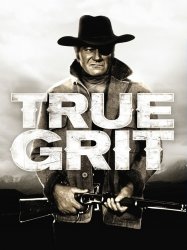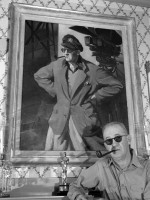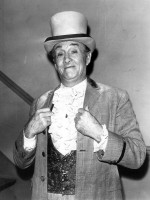John Wayne is a Actor, Director, Scriptwriter, Producer, Props and Property Master American born on 26 may 1907 at Winterset (USA)
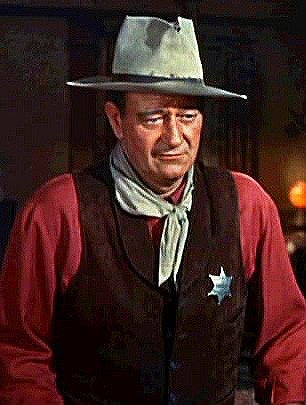
Marion Mitchell Morrison (born Marion Robert Morrison; May 26, 1907 – June 11, 1979), known by his stage name John Wayne, was an American film actor, director, and producer. An Academy Award-winner for True Grit (1969), Wayne was among the top box office draws for three decades. An enduring American icon, for several generations of Americans he epitomized rugged masculinity and is famous for his demeanor, including his distinctive calm voice, walk, and height.
Originally from Iowa, Wayne grew up in Southern California.
[...]See more...
[...]See more...
Source : Wikidata
John Wayne

Birth name Marion Robert Morrison
Nationality USA
Birth 26 may 1907 at Winterset (USA)
Death 11 june 1979 (at 72 years) at Los Angeles (USA)
Creator of Batjac Productions
Awards Academy Award for Best Actor, Presidential Medal of Freedom
Nationality USA
Birth 26 may 1907 at Winterset (USA)
Death 11 june 1979 (at 72 years) at Los Angeles (USA)
Creator of Batjac Productions
Awards Academy Award for Best Actor, Presidential Medal of Freedom
Originally from Iowa, Wayne grew up in Southern California.
[...]See more...
Biography
Wayne was married three times and divorced twice. He was fluent in Spanish and his three wives, each of Hispanic descent, were Josephine Alicia Saenz, Esperanza Baur, and Pilar Pallete. He had four children with Josephine: Michael Wayne (November 23, 1934 – April 2, 2003), Mary Antonia "Toni" Wayne LaCava (February 25, 1936 – December 6, 2000), Patrick Wayne (born July 15, 1939), and Melinda Wayne Munoz (born December 3, 1940). He had three more children with Pilar: Aissa Wayne (born March 31, 1956), John Ethan Wayne (born February 22, 1962), and Marisa Wayne (born February 22, 1966).[...]See more...
Best films
Usually with
Filmography of John Wayne (199 films)
Actor
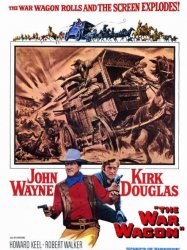
The War Wagon (1967)
, 1h41Directed by Bruce Cabot, Bruce Dern, Kirk Douglas, Gene Evans, Howard Keel, Robert Walker Jr., John Wayne, Keenan Wynn, Joanna Barnes, Burt Kennedy, Clair Huffaker
Origin USA
Genres Action, Crime, Western
Themes Heist films
Actors John Wayne, Kirk Douglas, Howard Keel, Robert Walker Jr., Keenan Wynn, Bruce Dern
Roles Taw Jackson
Rating68%





Rancher Taw Jackson (John Wayne) returns to his hometown to settle a score. Three years earlier, he was framed by corrupt businessman Frank Pierce (Bruce Cabot) and wrongfully imprisoned. Pierce did this to confiscate Jackson's land, where he had discovered gold. After his prison sentence was cut short for good behavior, Jackson returns to steal a shipment of gold from Pierce. He hires Lomax (Kirk Douglas) to assist him, even though he had worked as a hired gun for Pierce and was instrumental in sending him to prison.
[...]See more...

El Dorado (1966)
, 2h6Directed by Howard Hawks
Origin USA
Genres Action, Adventure, Romance, Western
Themes Films about alcoholism, Medical-themed films, Films about drugs
Actors John Wayne, Robert Mitchum, James Caan, Arthur Hunnicutt, Charlene Holt, Paul Fix
Roles Cole Thornton
Rating74%





Cole Thornton (John Wayne), a gunslinger-for-hire, is hired by wealthy rancher Bart Jason (Ed Asner) to help him in a range war with the McDonald family in the town of El Dorado. The local sheriff, an old friend of Thornton, J. P. Harrah (Robert Mitchum) gives Cole more details that Jason had deliberately left out, including the possibility of having to side against Harrah. Unwilling to fight his friend, Thornton quits, to the relief of saloon owner Maudie (Charlene Holt), who is in love with Thornton (and was for a time a romantic interest of Harrah's).
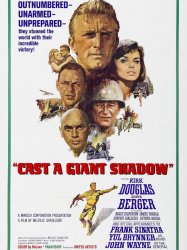
Cast a Giant Shadow (1966)
, 2h26Directed by Melville Shavelson
Origin USA
Genres Drama, War, Action, Historical
Themes Films set in Africa, Political films
Actors Kirk Douglas, Senta Berger, Angie Dickinson, Yul Brynner, James Donald, Frank Sinatra
Roles Gen. Mike Randolph
Rating62%





The film is a fictionalized account of the experiences of a real-life Jewish-American military officer, Colonel David "Mickey" Marcus, who commanded units of the fledgling Israel Defense Forces during the 1948 Arab-Israeli War.

The Greatest Story Ever Told (1965)
, 3h45Directed by George Stevens, David Lean, Jean Negulesco, William Hale, David S. Hall, Paul Baxley, Richard Talmadge
Origin USA
Genres Drama, Historical
Themes Films set in Africa, Films about religion, Films about sexuality, Films based on the Bible, Portrayals of Jesus in film, Films about virginity
Actors Max von Sydow, Charlton Heston, Martin Landau, Dorothy McGuire, José Ferrer, Telly Savalas
Roles Centurion at crucifixion
Rating64%





Ce film se veut une adaptation cinématographique de la vie de Jésus Christ telle que relatée selon le Nouveau Testament.

In Harm's Way (1965)
, 2h45Directed by Otto Preminger
Origin USA
Genres Drama, War, Action, Adventure
Themes Seafaring films, Transport films, Political films, United States Armed Forces in films
Actors John Wayne, Kirk Douglas, Henry Fonda, Patricia Neal, Brandon deWilde, Tom Tryon
Roles Capt. Rockwell Torrey
Rating72%





John Wayne stars as U.S. Navy Captain Rockwell "Rock" Torrey, a divorced "second generation Navy" son of a career Chief Petty Officer. A Naval Academy graduate and career officer, Torrey is removed from command of his heavy cruiser for "throwing away the book" when pursuing the enemy and then being torpedoed by a Japanese submarine shortly after the attack on Pearl Harbor. Kirk Douglas portrays Torrey's executive officer, Commander (later Captain) Paul Eddington, a wayward sort of career officer who has resigned as a naval aviator and returned to the surface navy because of an unhappy marriage.
[...]See more...
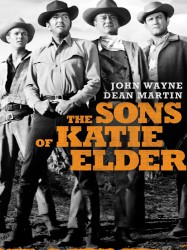
The Sons of Katie Elder (1965)
, 1h57Directed by Henry Hathaway
Origin USA
Genres Drama, Action, Adventure, Western
Themes Films about families
Actors John Wayne, Dean Martin, Martha Hyer, Michael Anderson Jr., Earl Holliman, George Kennedy
Roles John Elder
Rating70%





The four adult sons of Katie Elder – John (John Wayne), who is a famous (or infamous) professional gunman; Tom (Dean Martin), a professional gambler; Bud (Michael Anderson, Jr.), the youngest brother, still in school; and Matt (Earl Holliman), an unsuccessful hardware dealer – reunite in their hometown of Clearwaters, Texas (approximately 2 hours east of Dallas, Texas), in 1898 for their mother's funeral, sharing regret that none of them has lived up to her high expectations of them.

Circus World (1964)
, 2h16Directed by Henry Hathaway, Richard Talmadge
Origin USA
Genres Drama, Western
Themes Circus films
Actors John Wayne, Claudia Cardinale, Rita Hayworth, Lloyd Nolan, John Smith, Richard Conte
Roles Matt Masters
Rating61%





In 1901, Matt Masters (John Wayne), a Wild West circus star in the mold of Buffalo Bill Cody, bought a bankrupt circus in 1885 and successfully rebuilt it into a combination three ring and Wild West extravaganza, mixing Wild West Show acts with conventional circus acts in a winning combination. He has successfully toured the United States for more than a decade. Now that the century is about to turn, he wants to take his show to Europe.
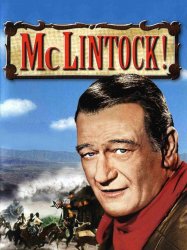
McLintock! (1963)
, 2h7Directed by John Wayne, Yvonne De Carlo, Maureen O'Hara, Andrew V. McLaglen, Patrick Wayne, James Edward Grant
Origin USA
Genres Drama, Comedy, Action, Adventure, Romance, Western
Themes Films based on plays, Films based on works by William Shakespeare
Actors John Wayne, Maureen O'Hara, Yvonne De Carlo, Patrick Wayne, Stefanie Powers, Edgar Buchanan
Roles George Washington McLintock
Rating70%





Cattle baron George Washington "G.W." McLintock (John Wayne) is living the single life on his ranch. He is estranged from wife Katherine (Maureen O'Hara), who left him two years before, suspecting him of adultery.

Donovan's Reef (1963)
, 1h49Directed by John Ford
Origin USA
Genres Comedy, Comedy-drama, Action, Adventure, Romance
Themes Seafaring films, Transport films
Actors John Wayne, Lee Marvin, Jack Warden, Elizabeth Allen, Cesar Romero, Dorothy Lamour
Roles Michael "Guns" Donovan
Rating66%





The film is a morality play in the guise of an action/comedy. It deals harshly (though not in an obvious way) with issues of racial bigotry, corporate connivance and greed, American beliefs of societal "superiority" and hypocrisy (i.e., the Boston shipping company considers carrying rum to be immoral, so they euphemistically refer to it as "West Indies goods"). Otherwise, Donovan's Reef is a light-hearted movie made in a period conforming, formulaic and sweetly naive manner (see "Critical Reception", below).
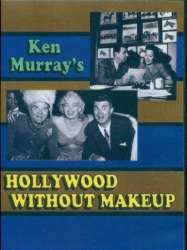
Hollywood Without Make-Up (1963)
Directed by Ken Murray
Origin USA
Genres Documentary
Themes Documentary films about business, Documentary films about the film industry, Documentary films about cities
Actors Kirk Douglas, Ken Murray, Cary Grant, June Allyson, George K. Arthur, Eddie Albert
Roles Self (archive footage)
Rating71%





The film consists of archive footage of famous Hollywood stars, mostly home movies showing the stars as themselves instead of playing a role in front of the camera.

The Longest Day (1962)
, 2h51Directed by Bernhard Wicki, Darryl F. Zanuck, Ken Annakin, Andrew Marton, Gerd Oswald
Origin USA
Genres Drama, War, Action, Historical
Themes Radio, Political films, Children's films, United States Armed Forces in films
Actors John Wayne, Henry Fonda, Patrick Barr, Richard Burton, Lyndon Brook, Robert Mitchum
Roles Lt. Col. Benjamin Vandervoort
Rating76%





The movie is filmed in the style of a docudrama. Beginning in the days leading up to D-Day, it concentrates on events on both sides of the channel, such as the Allies waiting for the break in the poor weather and anticipating the reaction of the Axis forces defending northern France. The film pays particular attention to the decision by Gen. Eisenhower, supreme commander of SHAEF, to go after reviewing the initial bad-weather reports as well as reports about the divisions within the German High Command as to where an invasion might happen or what the response to it should be.

How the West Was Won (1962)
, 2h35Directed by John Ford, Henry Hathaway, George Marshall, Richard Thorpe
Origin USA
Genres Drama, Action, Adventure, Historical, Western
Themes Political films
Actors James Stewart, Carroll Baker, Debbie Reynolds, Gregory Peck, George Peppard, Carolyn Jones
Roles Gen. William Tecumseh Sherman
Rating70%





Zebulon Prescott (Karl Malden) and his family set out west for the frontier via the Erie Canal, the “west” at this time being the Illinois country. On the journey, they meet mountain man Linus Rawlings (James Stewart), who is traveling east to Pittsburgh to trade his furs. He and Zebulon's daughter Eve (Carroll Baker) are attracted to each other, but Linus is not ready to settle down.

Hatari! (1962)
, 2h31Directed by Howard Hawks
Origin USA
Genres Comedy, Romantic comedy, Action, Adventure, Romance
Themes Films set in Africa, Films about animals, Mise en scène d'un éléphant, Mise en scène d'un mammifère
Actors John Wayne, Elsa Martinelli, Hardy Krüger, Red Buttons, Gérard Blain, Bruce Cabot
Roles Sean Mercer
Rating70%





Hatari! is the story of a group of adventurers in East Africa, engaged in the exciting and lucrative but dangerous business of catching wild animals for delivery to zoos around the world. As "Momella Game Ltd.", they operate from a compound near the town of Arusha. The head of the group is Sean Mercer (John Wayne); the others are safari veteran Little Wolf a/k/a "Indian" (Bruce Cabot), drivers "Pockets" (Red Buttons), and Kurt (Hardy Krüger), roper Luis (a Mexican former bullfighter; Valentin de Vargas), and Brandy (Michele Girardon), a young woman whose late father was a member of the group; she grew up there.
 , 2h3
, 2h3Directed by John Ford
Origin USA
Genres Thriller, Action, Western
Actors John Wayne, James Stewart, Vera Miles, Lee Marvin, Edmond O'Brien, Woody Strode
Roles Tom Doniphon
Rating80%





Senator Ransom "Ranse" Stoddard (James Stewart) and his wife Hallie (Vera Miles) arrive by train in the frontier town of Shinbone, in an unnamed western state, to attend the funeral of Tom Doniphon (John Wayne). As they make their way toward the undertaker's establishment to pay their respects to the deceased, a reporter (Joseph Hoover) and his editor, Maxwell Scott (Carleton Young) approach and ask Stoddard to explain why a United States Senator would make the long journey from Washington just to attend the funeral of a local rancher.
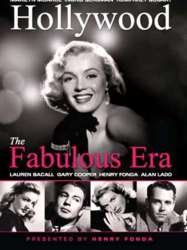
Hollywood: The Fabulous Era (1962)
, 1hDirected by Jack Haley Jr.
Origin USA
Genres Documentary
Themes Documentary films about business, Documentary films about the film industry, Documentary films about cities
Actors Lauren Bacall, Ingrid Bergman, Humphrey Bogart, Gary Cooper, Henry Fonda, Alan Ladd
Roles Himself (archive footage)
Rating69%





 Connection
Connection
